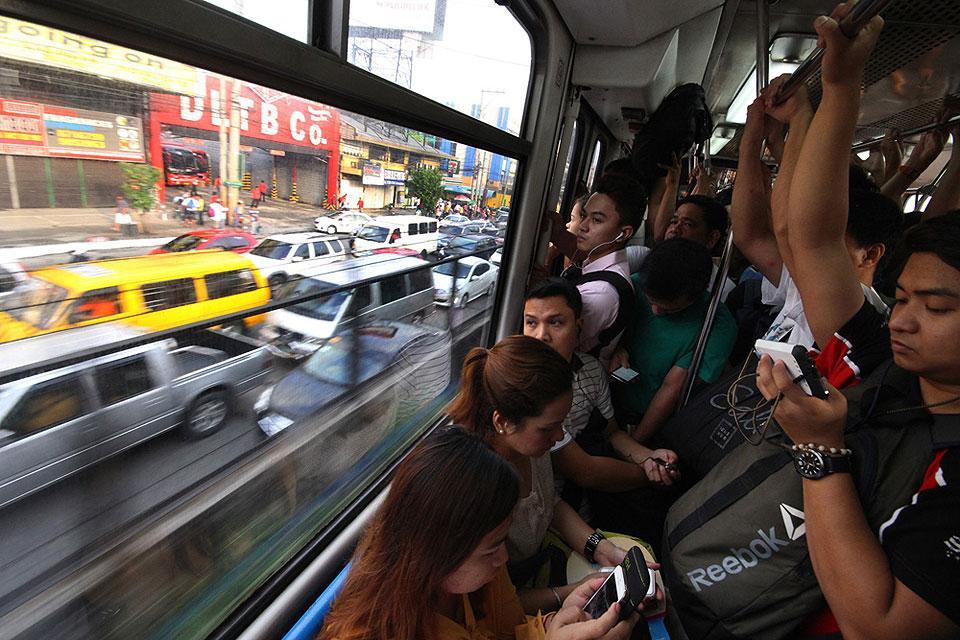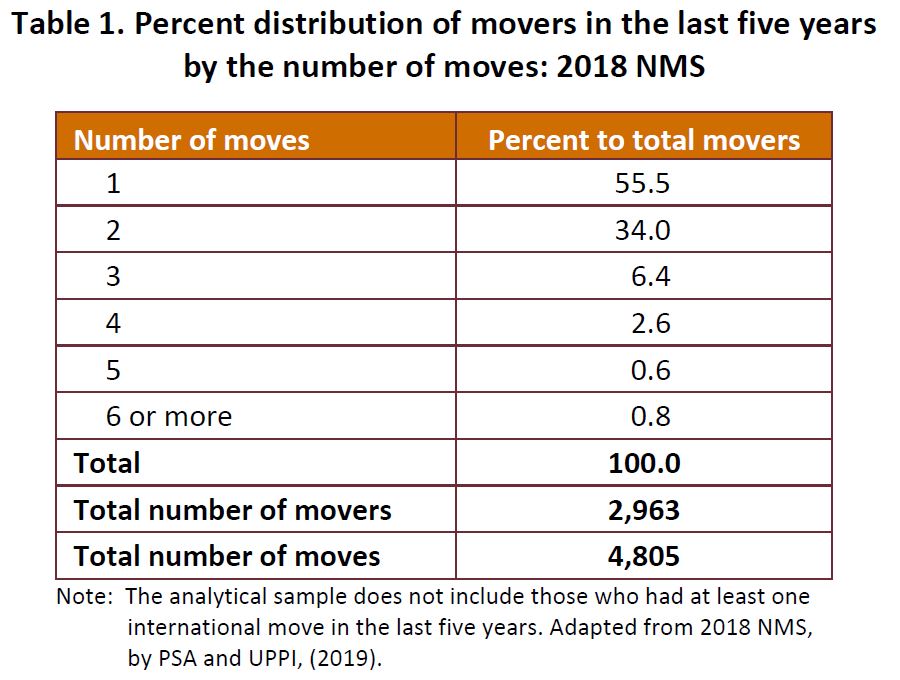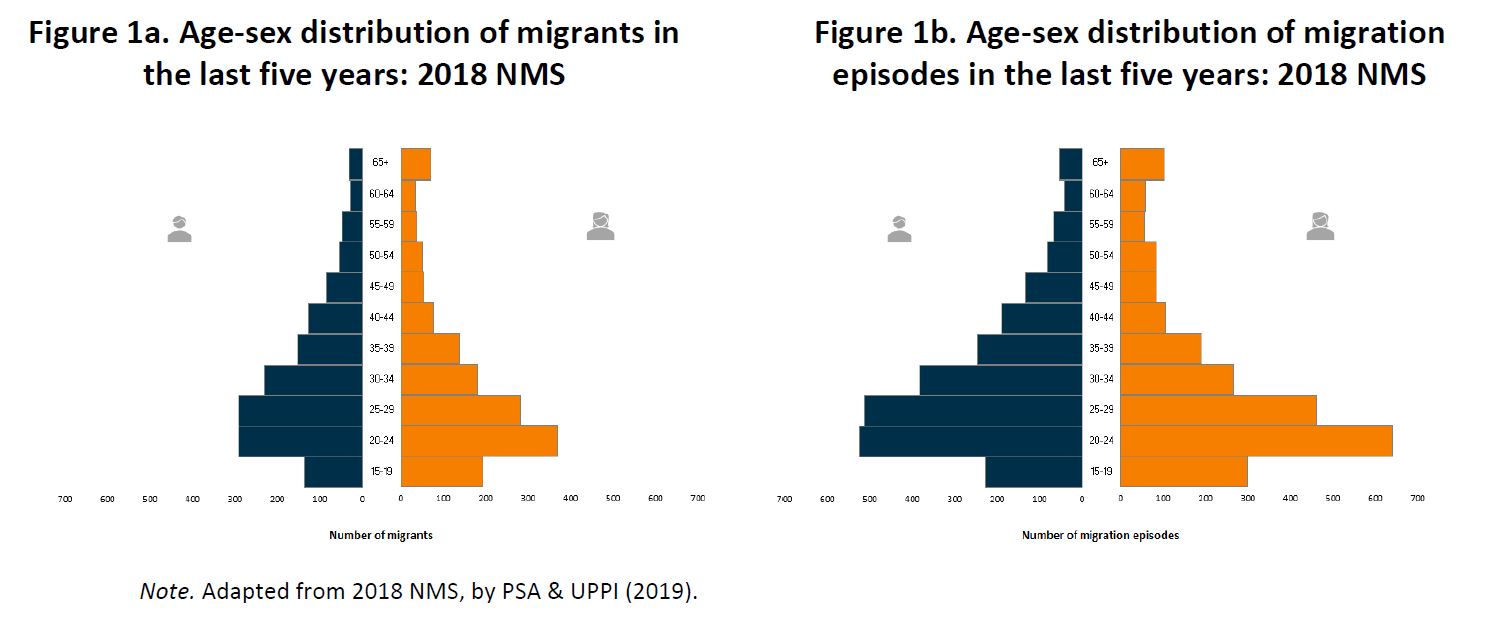
Moving Force: Factors Affecting Mobility of Filipinos
The University of the Philippines Population Institute (UPPI) in collaboration with the Demographic Research and Development Foundation (DRDF) are sharing results of their demographic studies to provide the Philippine context on the possible effects of the coronavirus disease (COVID-19) pandemic. In both the UPPI and DRDF websites, we are publishing a series of research briefs focusing on various aspects of Filipino lives that are affected by COVID-19, in both the short and long terms.
Download PDF here.
From the time of ancient seafaring to the age of modern flight, Filipinos have been on the move. Between 2005 and 2010, about 2.86 million Filipinos migrated, half of whom lived in a different province they lived in five years ago (NSO, 2013). Meanwhile, the results of the 2018 National Migration Survey (NMS) show that 15% of Filipinos also changed residence between 2013 and 2018. These moves involved either moving to a new city/municipality, province, region or country (PSA & UPPI, 2019).
While the long-distance movement of Filipinos is currently paralyzed by the coronavirus disease (COVID-19) pandemic, concerns about viral transmission across local boundaries may as well prompt the introduction of policies related to mobility and migration under the so-called new normal. For one, President Rodrigo Duterte signed Executive Order No. 114, S. 2020 that institutionalizes the ‘Balik-Probinsya, Bagong Pag-Asa Program’ (BP2). The EO attempts, among other things, to “reverse migration to the NCR and other congested metropolises.” However, even before implementing rules and guidelines were finalized, the implementation of the EO was suspended last 10 June 2020.
The previous research brief (UPPI & DRDF, 2020) sheds light on the limitations of the BP2 by discussing the results of the 2018 NMS, including the migration patterns of Filipinos and their reasons for moving. The report finds that in the last five years, 84% of migrants moved within the country, 14% had lived in another country, while the rest both had internal and international moves. Given that internal migrants make up the overwhelming majority of migrants, this research brief delves further into the determinants of internal migration in the Philippines, particularly patterns of recurrent movements by highlighting the demographic and social groups that are more likely to move and what the findings imply for policymaking and/or crafting programs for equitable urban and rural growth.
How often do people move?
Migration is among the three population processes, together with fertility and mortality. But unlike birth and death, migration can happen, if at all, more than once in an individual’s lifetime (PSA & UPPI, 2019). Because the literature has observed that prior experience of migration increases the risk of migrating again, it is worthwhile to study the determinants of Filipinos’ recurrent or repeat migration experience between 2013 and 2018, which the NMS 2018 data set readily provides.
We differentiate between the unique individuals, i.e. the respondents themselves, and the observations, which refer to the migration episodes that may occur multiple times for each subject. For this reason, the total number of moves is higher than the number of movers, as Table 1 shows.

Based on the 2018 NMS, the majority of migrants (55.5%) in the last five years moved only once, which suggests that they have settled after their first move. Still, a sizable proportion of migrants (34%) moved twice, as Table 1 shows. Further analysis would show that prior migration experience influences the likelihood of moving again. In particular, many of those who failed to settle after their first move tend to do so after their second move, after which the risk of migration increases again (Afable, 2020).
Determinants of Internal Migration
The key assumption of the study is that for each individual, each characteristic more or less holds and did not change in the last five years, e.g. current household wealth is the same as five years ago. The results1 of the analysis are as follows:
Age and sex. Age and sex are found to be significant determinants of internal migration. The data show that females are more likely to migrate than males, but males are about 15% more likely to migrate several times than females This sex differential in migration experience, however, is not consistent across age groups. Figures 1a and 1b show that at the extreme ends, e.g. ages below 25 and ages 60 and over, there are generally more female migrants than males, and they are also more likely to experience recurrent migration. The scenario is opposite at age 25 to 59.

In general, migration is a very active and dynamic process at the younger ages, as supported by the succeeding findings on educational attainment and prior work experience.
Education and wealth. Relative to those without schooling, those who completed secondary education are 1.86 times or 86% more likely to migrate. Similarly, those who completed college are twice more likely to move than those with no education. Of course, this is without prejudice to the fact that a number of migrants in the last five years also moved to study.
Paradoxically, those who come from poorer households are more likely to migrate than their richer counterparts, who are presumed to be more formally educated. To be exact, those who belong to the lowest wealth quintile are 64% times more likely to migrate than the richest 20%. This indicates that those with lower education may find it harder to move, but poverty may be their impetus for migration. In such an event, they tend to repeat it. Earlier research has shown that repeat migrants are mostly engaged in seasonal or contractual work such as farming, manual labor/transportation, and housework/childcare (Quisumbing & McNiven, 2006).
Marital status. Single Filipinos are 17% more likely to migrate than married individuals. This suggests that life events such as marriage are one of the reasons for migration. When couples marry, there is an intention to settle in the place of destination.
More curiously, those who are in common-law/live-in arrangement are 1.68 times more migratory than single individuals, who can supposedly exercise greater mobility. A possible explanation for this is that if poorer individuals are more likely to move, and poorer couples are more likely not to formally marry (Williams et al., 2007), those who are in common-law/live-in arrangement are also more likely to move. Conversely, single individuals may indeed have more freedom to move, but they see a lesser need for it given their relative comfort.
Multilingualism. Assuming that multilingual speakers acquired their languages before moving, it has been shown that multilingual Filipinos are 74% times more likely to migrate than those who can only speak a single language. The ability to speak multiple languages may give migrants greater confidence, especially if their language is widely used in their areas of destination.
Internal migration experience before 2013. Those who have prior experience of internal migration are 74% more likely to repeat their migration, supporting the finding that prior migration experience affects prospects of migration.
Work experience before 2013. Having no prior work experience serves as a proxy for potential first-time job-seeking. It has been shown that those without prior work experience are about twice more likely to migrate than those with prior experience. This suggests that job-seeking is among the key reasons for Filipinos’ migration, as the NMS report also stated.
Filipino mobility in context
Migration is a complex process that reflects an individual’s experiences, conditions, and capital (De Jong et al., 1986). But on a larger scale, migration is shaped by demographic, social, cultural, and economic forces, and hence has important implications on regional development. As the previous research brief noted, we are yet to see how the COVID-19 crisis will change Filipinos’ migratory behavior. But if migration will be their “adaptive mechanism” (Abad, 1981) to the crisis and a multitude of other problems that the pandemic compounded, any internal migration policy should take into account the characteristics of migrants, their varied motivations for moving, and why some are more migratory than others.
This research finds that economic needs—employment, primarily—remain to be the primary driver of internal migration in the Philippines. Addressing this requires both multi-sectoral and structural approaches.
In particular, it has been found that first-time job-seeking is a determinant of internal migration, and so a migration policy should help facilitate the exchange of labor market information between jobseekers and employers within and among provinces or regions. Careful set of policies should also be in place to address the job-skills mismatch of migrants (Comyn, et al. 2019), having noted earlier that while those with lower education are less likely to migrate, poverty and the nature of their work may push some of them into recurrent or “chronic” migration.
On the other hand, if any policy endeavors to “reverse” the migration to metropolitan areas, incentives for (re)migration should be adaptive to and adequately meet the needs of married individuals, who are less likely to move than their single counterparts. Again, employment is crucial, but it should also address the gaps in land tenure and agricultural opportunities, housing, healthcare, education, and other social services in the migrants’ respective home regions or provinces (Pernia et al., 1983; Quisumbing & McNiven, 2006).
The analysis of migration patterns also revealed that while there are significantly more female migrants than male migrants, males tend to be more recurrent migrants than females across the dominant labor ages of 25 to 59. Meanwhile, there are more female migrants at schooling and early employment ages, as well as at the retirement ages. This possibly reflects the employment imbalance between males and females. At any rate, more research is required to better understand this peculiar finding, including how migration relates to life cycle events such as labor migration, marriage, family formation, and retirement.
References:
Abad, R. (1981). Internal Migration in the Philippines: A Review of Research Findings. Philippine Studies, 29(2): 129-43. Retrieved from http://www.jstor.org/stable/42632583.
Afable, S. B. (2020). Determinants of Recurrent Internal Migration in the Philippines: Comparison Between Variance-Corrected Model and Shared Frailty Model for Recurrent Events. Unpublished manuscript.
Comyn, P., Strietska-Ilina, O., & Bergin, A. (Eds.). (2019). Skills and Jobs Mismatches In Low- And Middle-Income Countries. Geneva: International Labour Organization.
De Jong, G., Root, B., Gardner, R., Fawcett, J., & Abad, G. (1986). Migration Intentions and Behavior: Decision Making in a Rural Philippine Province. Population and Environment, No. 1 & 2, 41-62.
Exec. Order No. 114 (2020). https://www.officialgazette.gov.ph/downloads/2020/05may/20200506-EO-114-…
National Statistics Office (2013). 2010 Census of Population and Housing, Report No. 2A – Demographic and Housing Characteristics (Non-Sample Variables).
Pernia, E., Paderanga, C. Jr., Hermoso, P. & associates (1983). The spatial and urban dimensions of development in the Philippines. Philippine Institute for Development Studies. Retrieved from https://core.ac.uk/download/pdf/7105491.pdf
Philippine Statistics Authority (PSA) and University of the Philippines Population Institute (UPPI) (2019). 2018 National Migration Survey. Quezon City, Philippines: PSA and UPPI.
Quisumbing, A. & McNiven, S. (2006). Migration and the Rural-Urban Continuum: Evidence from Bukidnon Philippines. Philippine Journal of Development, 61(1-2). Retrieved from https://ideas.repec.org/p/phd/pjdevt/pjd_2006_vol__xxxiii_nos__1and2-a.html
University of the Philippines Population Institute (UPPI) and Demographic Research and Development Foundation, Inc. (DRDF). (2020, May). Balik Probinsya in time of COVID19. Retrieved from https://www.uppi.upd.edu.ph/sites/default/files/pdf/COVID-19-Research-Br…
Williams, L., Kabamalan, M., & Ogena, N. (2007). Cohabitation in the Philippines: Attitudes and Behaviors Among Young Men and Women. Journal of Marriage and Family, 69: 5, 1244-1256.
1 Results from shared-frailty parametric regression modeling, with the survival function following a Gompertz distribution and the shared frailty following a Gamma distribution (see Afable, 2020).
This research brief was prepared by Sanny Boy D. Afable, Grace T. Cruz, Maria Midea M. Kabamalan, Elma P. Laguna, Nimfa B. Ogena, Maria Paz N. Marquez, Micaella Lou-Andrea M. Garduce.
Suggested citation: University of the Philippines Population Institute (UPPI) and Demographic Research and Development Foundation, Inc. (DRDF). (2020, June). Moving Force: Factors Affecting Mobility of Filipinos (UPPI/DRDF Research Brief No. 6). Retrieved from https://www.uppi.upd.edu.ph/sites/default/files/pdf/COVID-19-Research-Brief-06.pdf.
